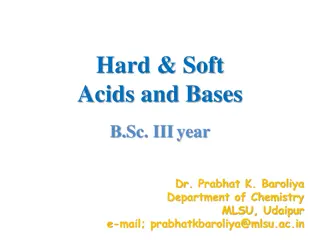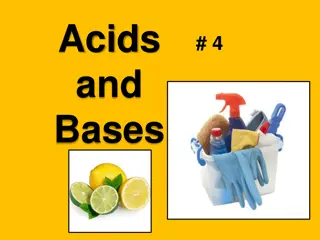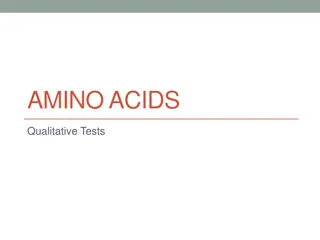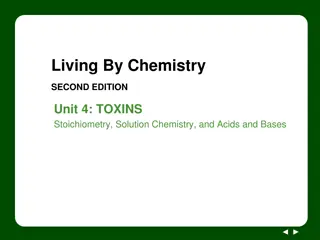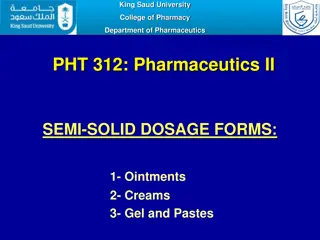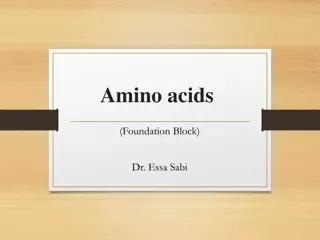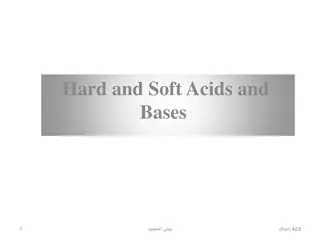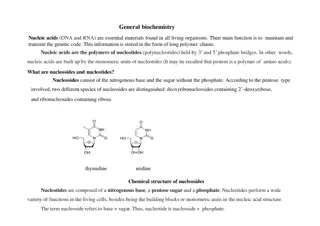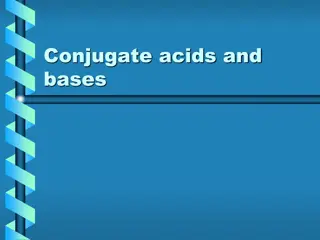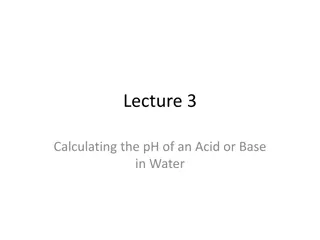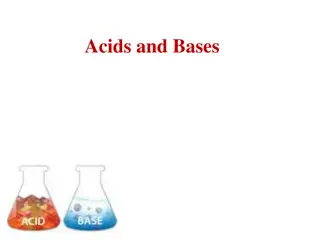Understanding Hard and Soft Acids and Bases (HSAB Principles) by Dr. Gurpreet Kaur
Delve into the world of Hard and Soft Acids and Bases (HSAB) with Dr. Gurpreet Kaur as she explains the characteristics of hard and soft acids, Pearson's HSAB principle, applications such as predictions of coordination in complexes, poisonings of metal catalysts, and the classification of acids and bases based on their reactivity preferences. Explore how the HSAB principle aids in understanding the occurrence of certain ores and minerals. Discover the significance of hard acid metal ions and how some metal catalysts can be poisoned based on their interaction with ligands.
Download Presentation

Please find below an Image/Link to download the presentation.
The content on the website is provided AS IS for your information and personal use only. It may not be sold, licensed, or shared on other websites without obtaining consent from the author. Download presentation by click this link. If you encounter any issues during the download, it is possible that the publisher has removed the file from their server.
E N D
Presentation Transcript
HARD & SOFT ACIDS AND BASES (HSAB) Dr. Gurpreet Kaur Assistant Professor PGGCG-42 Chandigarh
HARD & SOFT ACIDS AND BASES CHARACTERISTICS OF HARD ACIDS: THE HARD ACIDS ARE CATIONS WITH SMALL SIZE. WHEREVER DIFFERENT OXIDATION STATES ARE POSSIBLE THE HARD ACIDS ARE CATIONS OF HIGHER OXIDATION STATES. THE HARD ACIDS DO NOT POSSESS LARGE NUMBER OF VALENCE ELECTRONS. CHARACTERISTICS OF SOFT ACIDS: THE SOFT ACIDS HAVE CATIONS OF LARGE SIZE. THE CATIONS HAVE USUALLY ZERO OR LOW OXIDATION STATES. THE SOFT ACIDS HAVE USUALLY LARGE NUMBER OF VALENCE ELECTRONS.
2. Prediction of coordination in complexes of ambidentate ligands- The HSAB principle can also predict the formation of various metal ion complexes with ambidentate ligands. An ambidentate ligands is a mono dentate ligand which can coordinate to metal ion through more than one coordinating atoms e.g SCN- ion is an ambidentate ligands as it can coordinate through N or S.
3. Classification of Acids and bases The acids and bases can be classified as hard and soft depending upon their preference for hard or soft reactants .
4. Occurencee of ores and minerals The occurrence of the ores of certain metals can be explained on the basis of HSAB principle for example hard acid metal ions such as Mg2+ , Ca2+ occur mostly as their oxides , carbonates or halides. 5. Poisoning of metal catalysts HSAB principle can explain the poisoning of metal catalyst. Some metals like Ni, Pt, Pd, Cr, Mo (soft acids) act as catalyst. These metal catalyst can be easily poisoned by substances like CO, unsaturated hydrocarbons, phosphorous, arsenic containing ligands. This poisoning is attributed to the soft acid-soft base interactions between soft metal ions and soft ligands. These ligands are strongly adsorbed on the surface of the metal and thus block the active sites. These soft acid catalysts are not affected by hard bases or ligands containing N, O or F.
THEORETICAL BASIS OF HARDNESS & SOFTNESS- HSAB PRINCIPLE Several theories have been given to explain the stability of complexes Formed by hard-hard and soft-soft interactions. Some important theories are: 1. - Bonding theory : This theory was given by Mulliken (1955) and chatt (1956) to explain soft soft interaction on the basis of -bonding. Soft acids have low oxidation state and have a large number of d-electrons. Thus, they have a strong tendency to form -bonds with soft base which are also good bonding ligands. The polarization of soft acids and soft base also favour -bonding. 2. Electrostatic Interactions: According to this theory, ionic bond is formed by the interaction of hard acids and hard bases. In other words, hard-hard interactions are purely ionic or electrostatic. The electrostatic force of attraction between two oppositely charged ions is inversely proportional to the internuclear distance. The internuclear distance will be less in case of smaller ions. Therefore, the electrostatic attraction between two ions will be greater and consequently the resulting compound formed by hard acid and hard base will be highly stable
3. Polarizing power and Polarizability: Covalent bond is formed by the interaction of soft acids and soft bases. This is because the soft acids and soft bases have large size. The polarization effects are, therefore important to explain their interactions. Soft acids are generally transition metal ions having six or more d-electrons. The d-sub shell are easily polarized. Therefore, the complexes formed by soft acids and soft bases have covalent bonding and are stable. 4. Electronegativity and Hardness & softness: In general, Species with high electronegativity are hard Species with low electronegativity are soft The relation between electronegativity and hardness helps to explain the fact that CF3 is considerably harder than CH3 and BF3 is harder than BH3.
ACID-BASE STRENGTH AND HARDNESS & SOFTNESS Inherent acid base strength is quite distinguished feature from the hardness and softness. Hardness - softness pertains to the stability achieved due to hard-hard and soft soft interactions. Soft base SO32- can displace hard base F- SO32- + HF ===== HSO3- + F- However, this reaction occurs though it violates HSAB principle. When both the strengths of acids and bases and hardness-softness are not significantly different, HSAB principle is obeyed. E.g. Keq = 104
Limitation of HSAB Concept /Principle Hard and soft classification is useful concept no doubt but it has some tricky limitations as pointed out below:- 1. The prime limitation f the HSAB concept is that it is widely general and has no any direct quantitative scale of acid base strength . 2. The inherent acid base strengths are not accounted for e.g. OH- and F- ions are both hard bases where OH- is nearly 1013 times stronger base than F- ions .Correlation between hardness and inherent acid base strength is yet to be developed. 3. Sometimes Hard Soft principal fails to keep parity with inherent acid-base strengths. e.g. CH3(g) + H2(g) This reaction must be favoured in the view of soft-soft combination between CH3 and H- . But in actual practice the combination is endothermic by about + 360 kJ/mol. This unfavourable entropy change dose not allow the reaction to proceed. CH4(g) + H + (g)
SYMBIOSIS Soft ligands have a tendency to combine with a metal ion already having soft ligands and hard ligands have a tendency to combine with a metal ion already having hard ligands. This tendency is known as symbiosis. BF3 is a hard acid combines readily with a further F-- ion which is a hard base .While BH3 being a soft acid prefers to join the softer base H ion .This fact will easily account for the following : BF3 H- + BH4 F BF4-+ BH4- CF3H + CH3F CF4 + CH4 Such tendencies of fluoride ions or hydride ions to favour further coordination by a fourth F and H ion has been termed symbiosis by Jorgensen(1964) for the symmetrically substituted species with a centre already having soft ligands or vice Versa.
ELECTRONEGATIVITY AND HARDNESS & SOFTNESS The most important atomic property which helps in classifying hard and soft acids and bases is the electronegativity. It may be noted that in this electronegativity does not mean the power of an atom in a molecule to attract electrons towards itself but it refers also to the power of an individual ion participating in a reaction. For example lithium has low electronegativity, Li+ has relatively high tendency to attract electrons toward itself, and therefore, it has high electronegativity. This is because of extremely high second ionisation potential. Consequently, Li+ is hard acid. On the other hand, transition metal ions in low oxidation state such as Cu+ , Hg+ , Ag+ , Cd2+ etc have relatively high second ionisation energies and therefore have low value of electronegativity. Therefore, they are considered as soft acids. The same way we can consider hard and soft bases. For more details, please refer Proc. Nati. Acad. Sci. USA vol. 83, pp. 8440-8441, November 1986 chemistry



